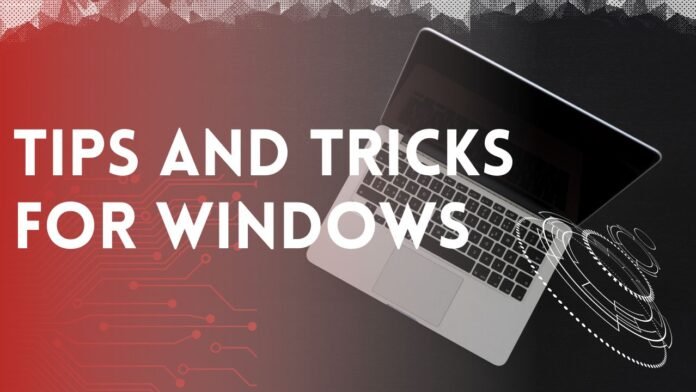Even though it’s not always equal to money, time is still important. You might be doing something you love every second that you don’t enjoy doing things like clumsily navigating Windows or slogging through context menus. And since technology plays such a large role in our life, those lost seconds add up quickly.
It’s time to get back those minutes, hours, and seconds that you lost. When used in tandem, these straightforward Windows 10 tips and techniques can significantly improve workflow. To be honest, most of them aren’t even that new.
Modify the programs that launch automatically.
Windows Tips and Tricks
Let’s begin at the very beginning:
The moment your computer boots up. Every program you install seems to find a way to activate alongside your computer. Certain apps, like the management app on your keyboard or your antivirus program, are deserving of such high regard. Some don’t. I am addressing you, game launchers. Additionally, every program that launches as soon as Windows boots up slows down how well you can use your computer, particularly if you haven’t upgraded to an SSD yet.
Thankfully, taking control of which Windows apps launch is simple. To launch the Windows 10 Task Manager, just press Ctrl + Shift + Esc or search for “Task Manager.” Next, select the Startup tab at the top.
Every program vying for a position in the startup spotlight can be seen there, along with an anticipated impact rating ranging from Low to High. To deactivate any, just click its listing and choose Disable. Naturally, doing so implies that you will now have to manually launch the application in order to activate it.
Personalize your task bar:
Let’s start arranging things a little more carefully now. It’s always quicker to open an application that’s pinned to your Windows 10 taskbar than to search for it on your desktop or in the Start menu. Thus, you should load yours with the applications and files that you utilize the most.
Just right-click on the program you want to pin to your taskbar, and from the context menu that displays, choose Pin to Taskbar. This can also be applied to a program’s taskbar icon that you see after opening it. Frequently frequented URLs can be pinned to your taskbar by right-clicking the shortcut on your desktop and choosing Pin to taskbar after you’ve saved it as a shortcut using the browser’s settings menu.
Unfortunately, you can only pin folders to the Start menu. You can kind of-sorta pin particular files to your taskbar, but the procedure is a little bit different, which leads to our next piece of advice.
Accept jump lists:
After you’ve pinned your frequently used apps to the taskbar, you can now utilize the amazing features of jump lists. Most taskbar icons will show you a pop-up list of the files you’ve recently opened for that program when you right-click on it, or shortcuts to frequently used tasks. It’s a fantastic method to get back into a project quickly without having to spend time navigating through Windows File Explorer’s numerous subfolders.
Even better, you can pin a file or shortcut to the top of the jump list if you know you’ll be returning to it frequently. Just mouse over the entry and click the pin symbol that pops up on the far right of the screen.
In the past, you could access particular applications that were pinned to your taskbar by simultaneously pressing the Windows key and the number that corresponded to the program’s location to the right of the Start Menu. For example, you could press Win + 1 to access your first pinned option, Win + 2 to open your second option, and so on. It appears to have vanished in Windows 10, even though it remains functional in previous iterations of the operating system.
In Windows 10, use Win + T to open programs pinned to your taskbar using your keyboard. The first pinned item to the right of the Start Menu will have a box surrounding it. Press Enter to open it, or keep pressing T to cycle through all your pinned programs from left to right.
Shortcuts on the keyboard:
Keeping with that trend, keyboard shortcuts allow you to complete activities far more quickly than if you were to use a mouse to navigate menus. In case you’re not familiar with keyboard shortcuts, here is a list of some of the more practical ones:
- Crtl plus C: Copy the shortcut Ctrl + X. Cut: Ctrl + V; Paste; Undo:
- Ctrl + Z (most software supports these Ctrl shortcuts).
- Press Alt + Tab to: Go through the available programs in turn.
- Win + Tab: Display all open programs for each display individually, bring up Windows Timeline
- Windows key Launch a search
Windows plus - E: Launch File Explorer.
Windows together with Print Screen: takes a picture and stores it in the Pictures folder. - Windows + I to Launch Windows Preferences
- Ctrl + Shift + Esc: F5: Refresh the active window in Task Manager
Visit Microsoft’s support website to view this cheat sheet, which has a complete list of all keyboard shortcuts for Windows 10. Not all of them, but the most, ought to function with earlier iterations of Windows.
Create your own keyboard shortcuts:
The built-in keyboard shortcuts in Windows 10 don’t have to stop you. Additionally, you can design unique keyboard shortcuts to launch apps rapidly.
Right-click the app and choose Create shortcut to accomplish this. A new icon with the program’s name and the word “shortcut” at the end will show up. To access the Properties of the software, right-click on its shortcut. Choose the Shortcut tab from the pop-up menu that displays, click the Shortcut Key field, and then hit the alphanumeric key you want to link to the software. To save the changes, click OK. To launch the software, Windows will set the keyboard shortcut Crtl + Alt + .
When it comes to managing applications that you use frequently but not frequently enough to pin to your taskbar, this tip might be really helpful. I enjoy using it to activate the several game launchers that are installed on my PC, matching the keyboard shortcut’s letter to the game launcher’s first letter.
Put everything on hold:
You can end up with an excessive number of open windows if you’re opening apps and files at random. Do not worry; Windows offers a number of ways to quickly clean the screen so you can get back to work on the task at hand.
My best choice? Holding down the title bar at the top of the software you’re using will cause it to tremble violently. Each and every other window will be reduced to the taskbar. The same can be done by pressing Windows + Home. As an alternative, you can press Windows + D on your keyboard to minimize everything and display your desktop, or you can click the sliver that is barely visible all the way to the right of your taskbar, past the notification center and system tray.
Enhance the Send To menu:
Maintaining organization is essential for productive work. To maintain your virtual home tidy, you can use the Send To option from the right-click context menu, but you’ll need to modify the menu to suit your needs. It is quick to do this. and definitely worth the effort.
Make shortcuts to the folders you use the most first. (For example, I enjoy making a shortcut to my PCWorld work folder.) After that is finished, launch File Explorer and enter shell:send to in the upper location bar. A list of the options available in the Send To menu will be displayed in File Explorer. To add your previously made shortcuts, just drag them into this folder. Those folders will be presented as possibilities the next time you right-click an item to bring up the Send To menu. Enjoy your sorting!
This PC or Quick Access?
It may be useful to modify the place to which File Explorer opens while you’re in there. File Explorer’s default setting in Windows 10 is Quick Access, which shows your most recently used files and frequently as well as often utilized folders. Sounds convenient, doesn’t it? Not too much if you already make use of your taskbar’s jump lists. The antithesis of what Quick Access offers, if you’ve configured your system according to this method, you’re far more likely to trawl through File Explorer in search of seldom used objects.
Thankfully, you can alter File Explorer’s behavior so that it opens to the “This PC” interface, allowing you to explore your hard drives’ subfolders in more detail. Open File Explorer, select the View tab, and then click Options to accomplish this. Choose the only option that appears, “Change folders and search options.” Select Quick Access or This PC from the drop-down menu labeled “Open File Explorer to” at the top of the pop-up window that appears.
Boost your power:
Finally, if you’ve mastered these straightforward yet effective tips, exploring the fascinating world of Windows power tools may help you save even more time. You can further optimize your workflow with the assistance of other enthusiast-class tools like Timeline, Nearby Sharing, Cloud Clipboard, Storage Sense, and God Mode. If you want to go even farther down this rabbit hole, check out our guide to 10 little-known Windows features that will blow your mind or our tutorial on optimizing Windows 10 for laser-focused productivity if you want to reduce disruptions
Found this article interesting? Follow BG on Facebook, Twitter and Instagram to read more exclusive content we post.

